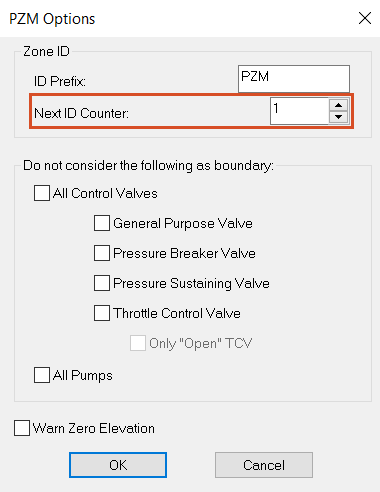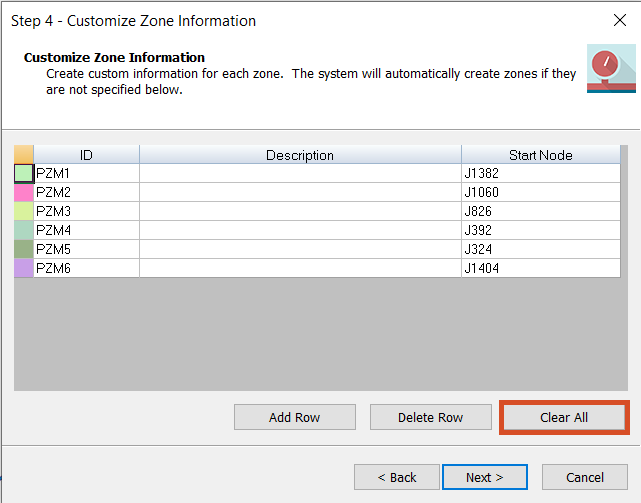& Construction

Integrated BIM tools, including Revit, AutoCAD, and Civil 3D
& Manufacturing

Professional CAD/CAM tools built on Inventor and AutoCAD
Transcript
00:04
After running a pressure zone manager, trace and analysis,
00:07
you can merge pressure zones in your model
00:10
to begin
00:11
double click the desired project dot
00:13
X file to open
00:15
Agis Pro.
00:16
Once the project starts,
00:18
click the info water pro tab to open the info water pro ribbon
00:22
in the project panel, click initialize
00:26
in a previous PCM run. It was discovered that PGM six should be merged with PGM three.
00:33
In this exercise, you will merge these two zones into a single pressure zone
00:38
on the info water pro ribbon in the project panel, click apps
00:44
then double click P Z M
00:47
in the pressure zone manager, click options
00:52
in the PCM options, dialogue under zone id set, the next ID counter to one
00:58
then click OK.
01:00
This is because the PC M tool has been run prior to this exercise.
01:05
However, if you just started, you would start with PC M seven rather than PC M one.
01:11
So make sure you reset this any time you rerun the PZ M tool.
01:15
Click new to start the pressure zone wizard
01:19
on the first page next to store the elements, zone id in this field, enter zone
01:24
id
01:26
for output time. Enter zero hours.
01:29
Click next
01:32
for step one in the definition of trace area group,
01:35
select no user defined boundary pipes.
01:37
Then click next
01:40
on the step two page.
01:41
You can define intra zone elements for the PC M to ignore them as zone delineates
01:46
but still treat them like junctions in the simulation.
01:49
Click add row
01:51
in the new row, expand the type, drop down and set it to pump.
01:56
Then click select element
01:59
in the model zoom in and select pump P 100
02:04
pump P 100 is the north pump connected to W T P 100 that was included in PCM six.
02:10
In the original analysis,
02:12
you can also type in the pump id rather than manually selecting it from the map.
02:17
Click add row again and repeat these steps to add pump P 120 to a new row.
02:23
Now these pumps will be included in the closest pressure zone.
02:27
Click next
02:28
for step three, no boundary pipe elements are a user to find. So click next
02:34
on the step four page,
02:35
you can see the customized zone information for the six
02:38
start nodes that was created during the earlier run.
02:41
Click clear all to remove this information and then click next
02:46
on the trace and analyze page. Click run
02:50
the PCM performs a trace analysis to identify pressure zones in the model.
02:54
With the updated information you provided,
02:57
you can see that five pressure zones are created
03:00
PCM. One to PCM five
03:03
PZ M six no longer exists and is now part of PZ three.
03:08
Click finish to close the wizard and return to the pressure zone manager
03:13
in the pressure zone manager.
03:15
Click the cell above the zone list to select all the zones and then click show zone,
03:21
move the pressure zone manager window to the side
03:23
and view the map with all pressure zones,
03:25
color coded,
03:27
click close to exit the pressure zone manager.
00:04
After running a pressure zone manager, trace and analysis,
00:07
you can merge pressure zones in your model
00:10
to begin
00:11
double click the desired project dot
00:13
X file to open
00:15
Agis Pro.
00:16
Once the project starts,
00:18
click the info water pro tab to open the info water pro ribbon
00:22
in the project panel, click initialize
00:26
in a previous PCM run. It was discovered that PGM six should be merged with PGM three.
00:33
In this exercise, you will merge these two zones into a single pressure zone
00:38
on the info water pro ribbon in the project panel, click apps
00:44
then double click P Z M
00:47
in the pressure zone manager, click options
00:52
in the PCM options, dialogue under zone id set, the next ID counter to one
00:58
then click OK.
01:00
This is because the PC M tool has been run prior to this exercise.
01:05
However, if you just started, you would start with PC M seven rather than PC M one.
01:11
So make sure you reset this any time you rerun the PZ M tool.
01:15
Click new to start the pressure zone wizard
01:19
on the first page next to store the elements, zone id in this field, enter zone
01:24
id
01:26
for output time. Enter zero hours.
01:29
Click next
01:32
for step one in the definition of trace area group,
01:35
select no user defined boundary pipes.
01:37
Then click next
01:40
on the step two page.
01:41
You can define intra zone elements for the PC M to ignore them as zone delineates
01:46
but still treat them like junctions in the simulation.
01:49
Click add row
01:51
in the new row, expand the type, drop down and set it to pump.
01:56
Then click select element
01:59
in the model zoom in and select pump P 100
02:04
pump P 100 is the north pump connected to W T P 100 that was included in PCM six.
02:10
In the original analysis,
02:12
you can also type in the pump id rather than manually selecting it from the map.
02:17
Click add row again and repeat these steps to add pump P 120 to a new row.
02:23
Now these pumps will be included in the closest pressure zone.
02:27
Click next
02:28
for step three, no boundary pipe elements are a user to find. So click next
02:34
on the step four page,
02:35
you can see the customized zone information for the six
02:38
start nodes that was created during the earlier run.
02:41
Click clear all to remove this information and then click next
02:46
on the trace and analyze page. Click run
02:50
the PCM performs a trace analysis to identify pressure zones in the model.
02:54
With the updated information you provided,
02:57
you can see that five pressure zones are created
03:00
PCM. One to PCM five
03:03
PZ M six no longer exists and is now part of PZ three.
03:08
Click finish to close the wizard and return to the pressure zone manager
03:13
in the pressure zone manager.
03:15
Click the cell above the zone list to select all the zones and then click show zone,
03:21
move the pressure zone manager window to the side
03:23
and view the map with all pressure zones,
03:25
color coded,
03:27
click close to exit the pressure zone manager.
Required for course completion
After running a Pressure Zone Manager trace and analysis, you can merge pressure zones in your model.
In a previous PZM run, it was discovered that PZM6 should be merged with PZM3. To merge these two zones into a single pressure zone:

IMPORTANT: Resetting the Next ID Counter is necessary because the PZM tool has been run prior. However, if you just started, you would start with PZM7 rather than PZM1. So, make sure you reset this any time you re-run the PZM tool.

Note: Pump P-100 is the north pump connected to WTP100 that was included in PZM6 in the original analysis.

Pumps P-100 and P-120 will now be included in the closest pressure zone.

The PZM performs a trace analysis to identify pressure zones in the model with the updated information.
Five pressure zones are created, PZM1 through PZM5. PZM6 no longer exists and is now part of PZM3.

